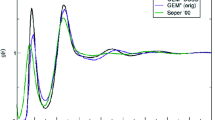Abstract
Computational modeling in the health sciences is still very challenging and much of the success has been despite the difficulties involved in integrating all of the technologies, software, and other tools necessary to answer complex questions. Very large-scale problems are open to questions of spatio-temporal scale, and whether physico-chemical complexity is matched by biological complexity. For example, for many reasons, many large-scale biomedical computations today still tend to use rather simplified physics/chemistry compared with the state of knowledge of the actual biology/biochemistry. The ability to invoke modern grid technologies offers the ability to create new paradigms for computing, enabling access of resources which facilitate spanning the biological scale.
Similar content being viewed by others
Explore related subjects
Discover the latest articles, news and stories from top researchers in related subjects.References
Gao, J. and Thompson, M. A. (eds.), “Combined Quantum Mechanical and Molecular Mechanical Methods,”ACS Symposium Series, No. 712, American Chemical Society, Washington, 1998.
Zhang, Y., Lee, T.-S. and Yang, W., “A Pseudobond Approach to Combining Quantum Mechanical and Molecular Mechanical Methods,”J. Chem. Phys., 110, pp. 46–54, 1999.
Schmidt, M. W., Baldridge, K. K., Boatz, J. A., Elbert, S. T., Gordon, M. S., Jensen, J. H., Koseki, S., Matsunaga, N., Nguyen, K. A., Su, S. J., Windus, T. L., Dupuis, M. and Montgomery, J. A.,J. Comput. Chem., 14, pp. 1347–1363, 1993, http://www.msg.ameslab.gov/GAMESS/GAMESS.html.
Abramson, D., Sosic, R., Giddy, J. and Hall, B., “Nimrod: A Tool for Performing Parametised Simulations Using Distributed Workstations,” inThe 4th IEEE Symposium on High Performance Distributed Computing, Virginia, Aug., 1995; Abramson, D., Giddy, J. and Kotler, L., “High Performance Parametric Modeling with Nimrod/G: Killer Application for the Global Grid?”, inInternational Parallel and Distributed Processing Symposium (IPDPS), Cancun, Mexico, May 2000, http://www.csse.monash.edu.au/~davida/nimrod/.
Foster, I. and Kesselman, C. (eds.),The Grid: Blueprint for a New Computing Infrastructure, Morgan Kaufmann Publishers, USA, 1999.
Frey, J., Tannenbaum, T., Foster, I., Livny, M. and Tuecke, S., “Condor-G: A Computation Management Agent for Multi-Institutional Grids,” inProc. of the Tenth IEEE Symposium on High Performance Distributed Computing (HPDC10), San Francisco, California, Aug. 2001.
Foster, I. and Kesselman, C., “Globus: A Metacomputing Infrastructure Toolkit,”Int. J. Supercomput. Appl., 11, pp. 115–128, 1997.
Author information
Authors and Affiliations
Additional information
Wibke Sudholt: She is a postdoc with J. A. McCammon and K. Baldridge at the University of California, San Diego and a fellow of the German Academic Exchange Service (DAAD). She received her diploma (Dipl. Chem.) at the University Dortmund, Germany in 1996, and her doctoral degree in 2001 (Dr. rer. nat.) at Heinrich-Heine-University Duesseldorf, Germany with Wolfgang Domcke on theoretical studies of a charge-transfer process. Her current research interests include the combination of quantum chemistry, molecular mechanics and continum electrostatics to describe chemical reactions in complex molecular systems.
Kim K. Baldridge: She is a theoretical and computational chemist with expertise in the design, development, and application of computational quantum chemical methodology for understanding chemical and biochemical reaction processes of broad interest. Efforts include development of computational tools and associated grid technologies for the broader scientific community. She is a Fellow of the APS and AAAS, and was the 2000 Agnes Fay Morgan Awardee for Research Achievement in Chemistry. She is the Program Director for Integrative Computational Sciences at SDSC, where she has worked since 1989, and additionally holds an adjunct professorship at UCSD.
David Abramson: He is currently a professor of Computer Science in the School of Computer Science and Software Engineering (CSSE) at Monash University, Australia. He is a project leader in the Co-operative Research Centre for Distributed Systems Nimrod Project and Chief Investigator on two ARC funded research projects. He is a co-founder of Active Tools P/L with Dr. Rok Sosic, established to commercialize the Nimrod project, and Guardsoft, focused on commercializing the Guard project. Abramson’s current interests are in high performance computer systems design and software engineering tools for programming parallel, distributed supercomputers.
Colin Enticott: He completed a BComp (Hons) degree mid. 2002 at Monash University, Australia. His project, done under the supervision of Professor David Abramson, “The Multi Site EnFuzion Client” dealt in the area of cluster-of-clusters computing that has lead him into Grid computing. Currently employed by DSTC (Distributed Systems Technology Centre, Melbourne, Australia) working on the user front-end of Nimrod (the Nimrod Portal) and cluster implementations.
Slavisa Garic: He completed Bachelor of Computer Science (Hons) degree at Monash University, Australia in November 2001. His project, “Suburban Area Networks: Security” involved working on security aspects of wireless community and suburban networks. The beginning of year 2002, he joined Distributed Systems Technology Centre, Melbourne Australia, where he currently works as a core Nimrod/G developer.
About this article
Cite this article
Sudholt, W., Baldridge, K.K., Abramson, D. et al. Parameter scan of an effective group difference pseudopotential using grid computing. New Gener Comput 22, 137–146 (2004). https://doi.org/10.1007/BF03040952
Received:
Revised:
Issue Date:
DOI: https://doi.org/10.1007/BF03040952




